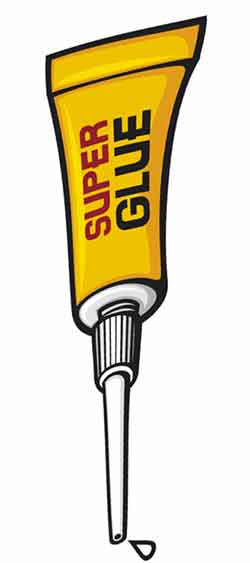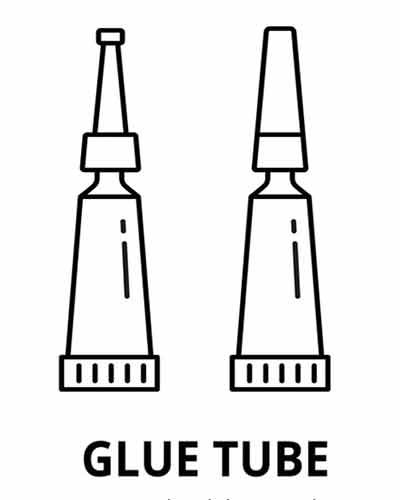Super glue as it is popularly known is a Cyanoacrylate adhesive which is a simple polar, linear molecule that polymerizes rapidly upon exposure to atmospheric moisture. This is actually why it is called Super glue.
For many people, super glue seems to be the most effective and convenient type of adhesive for use in various bonding applications. This is, in fact, true since most cyanoacrylate formulations are used in all types of general-purpose bonding.
The convenience of this adhesive is because it sets immediately it gets into contact with moisture and the surface of the object applied to. Super is also convenient to use because it cures very quickly compared to other popularly known adhesives.
Table of Contents
The History of Super Glue
Well, many of you might be wondering where this adhesive originated from, thankfully that will be answered in a few seconds, so just read on.

If you have read documentations about super glue, you might have come across lots of authors saying that super glue was an accidental invention. Well, it could battle wounds during the 2nd world war, but then instead of it turning out as plastic as was expected it came out slightly different as super glue.
Here are more details about the history; in 1942 the original chemical component in super glue (cyanoacrylate) was discovered during a search for materials that could make clear plastic gun sights for the war. While searching for these materials, scientists came upon a cyanoacrylate chemical that stuck to everything it came into contact with. Top researchers promptly rejected these chemical formulations because of their sticking characteristics.
It was only years later that this chemical substance was rediscovered and its real potential realized as an adhesive. It was after this that Harry Cover and his crew perfected the content and later gave it the name it holds today. The product was first introduced into the commercial market in 1958 and has from that time revolutionized the adhesive and glue industry which continues to grow tremendously even to this day.
How Does Super Glue Cure

As earlier stated, super glue is a fast curing adhesive that is very convenient to use. This all-purpose adhesive is easily dispensable as most of it is packed in tubes and jars with applicator tips.
Since moisture is super glue’s primary and only catalyst, upon dispensation, it mixes quickly with moisture molecules in the atmosphere where bonding then takes place in a matter of seconds. The bonding effect takes place in just moments depending on the viscosity of the glue. As it bonds, the adhesive attaches to applied surfaces securely and makes them strong enough to be within a matter of minutes. After several hours, in most cases 24 hours, the bonded items are usually fully cured, cemented, and ready for use.
For fast curing, users are often advised to ensure that the surfaces of the objects being bonded are clean and super smooth. This will allow for a quick and secure bond.
How to Use Super Glue
You can use super glue to bond like materials or similar surface combinations. To get the best results using super glue, it’s best to use the adhesive at room temperature and apply it on clean and smooth surfaces. Also, it’s a good idea to take a precautionary measure like working in a well-ventilated area, wearing protective clothing for bigger projects, covering the working area to avoid damaging nearby items with accidental spills. Also, you need to ensure that you read the instructions on the package before using any new super glue product.
If in any case, you accidentally inhale the fumes of the glue and the reaction takes a toll on you, ensure that you call a doctor immediately.
Three Types of Super Glue
One thing you should know before you embark on picking a super glue for your particular project is what type it is. While type is commonly associated with the brand, in this case, we are talking about the viscosity of the glue as there isn’t a one type fits all. Different surfaces require different super glue viscosities to produce desirable results.
There are three super glue viscosities: thin, medium, and thick. What about them?
The thin super glues are usually quite watery and are commonly used to fill small cracks in materials. The advantage of this glue is that it is easy to dispense, it quickly pulls itself into tight places, and it dries quickly. Curing also takes a short amount of time. In other words, thin super glues give an instant effect once applied.
Medium super glues are the most commonly used especially for DIY woodworking. This type of glue can be utilized to bind repairs and drop-fill finish repairs on level surfaces. It can also be used to attach waste wood to faceplate turning even on end grain or wet wood and for fretwork too.
Thick viscosity super glue, on the other hand, is best preferred for use when you need the glue to stay right where you put it. It is preferable over the other viscosities because it is thick and therefore doesn’t run nor sag after application. The glue can be used for drop filling dents, deep finish chips, and dings. Moreover, it can also be used for light gluing nuts because as stated it won’t run before you can position the nut.
Advantages of Super Glue
The benefits of using super glue over other types of adhesives are significant. Some of its advantages include;
- Fast curing. This is mentioned early in the article and yes the glue dries very quickly. It takes a few seconds to bond and about 24 hours to fully cure depending on the amount and size of the application. The best thing is that while some materials may require clamping for the glue to perfectly bond, you don’t need to do it for too long or apply too much pressure.
- Again, super glue is a pretty strong adhesive. When applied the right way and on clean surfaces, the adhesive will bond firmly and tightly leaving you with strongly cemented items that can be used in any normal way.
- Super glue is a clear substance. This means that regardless of the color or type of material being bonded, the excess glue won’t leave undesirable traces on the materials after curing. In any case, you can easily peel off/wipe the excess glue from the materials which will leave you with a beautifully bonded surface.
- It is available in different viscosities which means that you can choose any super glue that befits your kind of application.
- For the fact that it is fast-drying, the glue doesn’t need an additional catalyst to speed up the process. It sets and cures naturally provided it is at room temperature.
- Last but not least, you can use the glue to bond a variety of materials ranging from wood, plastic, etc.
Applications of glue
Much has been said about how to use super glue, and there has also been a brief mentioned on what applications super glue can be utilized. But truly, what are the uses of super glue, how and where can you use it?
First of all, super glue is an adhesive that can be utilized for many different projects. Here are some of its uses;
- If you are a hobbyist or a small-time craftsman, super glue can come in handy to help you bond different crafts and items that you create. For example, you can easily attach parts of a model airplane or car or whatever craft that you are making. This is why most hobby stores stock super glue because they know its usefulness and its durability at holding pieces together.
- Woodworkers also find this adhesive extremely useful. The glue can be used to fill cracks, dents, and deep voids in wood. Instead of using the regular screws and nuts to join pieces of wood together, super glue can be utilized as an alternative to firmly and securely bond the pieces of wood together.
- Another use of super glue in for nut and bolt retention. The adhesive helps to keep nuts and bolts from accidentally coming out; you may want to place a little dab of this incredible bonding agent over the end of your fasteners and fixings.
- Children are often rough on their toys. Dolls, toy cars, plastic guns, jewelry, dollhouses with all the small pieces and parts, as well as bicycles all have tiny parts that easily break apart. Buying toys can be an endless process. Gluing expensive toys can save a lot of money throughout the year. A strong super glue can be a valuable asset to the home.
- Super glue can be a big time saver when no other type of adhesive seems to work. Certain materials won’t just bond no matter how hard you try. Super glue in most of these cases tends to help especially when it’s plastic and rubber materials that won’t bond.
How to Choose the Best Super Glue
Sadly, there isn’t any particular formula to choosing the best super glue for your needs. But lucky for you, there are a few things that you can factor in to ensure that you pick only the best type of super glue for your applications. Here are a few tips to consider;
The materials you are bonding
When choosing any super glue, it is important that you consider the type of material to be bonded. Super glues have varied strengths, and one that will bond wood very well might not work the same way with plastic or rubber.
Viscosity, what is best for your project?
Remember that super glue is available in three viscosities; thin, medium, and thick. Certain projects require thin adhesives to work well i.e. projects that require deep and quick penetration like in filling small cracks. There are other situations like when fixing nuts where you will need to use thick superglue to avoid running and gaping before you replace the nut.
The bottom line is that you should choose the right viscosity for your project if you want to get the best results out of your super glue.
Ease of application
This is in relation to the type of applicator that is supplied with the super glue. You will find adhesives with brush applicators that are best for applying glue to large surfaces. There are bottle applicators with nozzles that can easily penetrate tight spaces. You will also find adhesives that only require you to squeeze the sides for the glue to come out. This type tends to allow you control over the amount of glue to dispense and where to dispense.
Most super glues for small and medium applications come in tubes that have a self-piercing cap. These types of applicators don’t cause any messes and are easy to use too.
Temperature resistance
Different grades of super glue will withstand different amounts of temperature. There are some that may struggle with high temperatures which means that the results won’t be desirable if applied in high-temperature areas. Most manufacturers list the resistance levels of their glues on the package. Therefore, be sure to read the packages to be able to choose the best glue for your needs.
My advice is to always go for those that are indeed temperature resistant as this means that they can withstand whatever temperature they will be subjected to.
Bonding strength
Another thing that you might want to consider is the strength of the bond the glue forms. Bonding is subjective; this means that different adhesives will bond depending on a variety of factors like environment, material, quality, and so on. This means that you have to pay attention to how much strength you require and know that all super glues will always create strong bonds, at least in a general sense, the difference only lies in the actual strength- this is where you need to pay your attention to.
Brand
There are various brands of super glue out there, and each one of these brands is competing to convince the consumer that theirs is the best regarding quality and other necessary factors. To be able to choose the perfect super glue, you need to familiarize yourself with the available brands and know which ones are known for producing quality regarding the type of super glue you are looking for.
Common super glue brands include Krazy, Gorilla, Original, and Loctite.
The final word
The good thing with super glue is that it can repair and bond just about anything. You only need to ensure that you choose the right type of super glue, clean and smoothen your surfaces, and apply the glue in moderation.
Just remember that irrespective of what you need to bond, super glue will pretty much do it for you. Be careful when using the glue especially when around kids or within their reach. Also, avoid incidences where the glue might get stuck on your fingers or clothes. Safety and precautionary measures must be taken when using super glue.
I hope this article answers most if not all of your questions about super glue. Good luck putting the knowledge into practice.



